#the keys are great enrichment
Note
hii-
love ur writing btw-
I was wondering if you could do a Ninjago headcanon, but the reader is touch-starved or something like that?
Thanks <3
Aaa thank you for your kind words!! And here you go :D
Ninjago - Ninjas with a Touch-Starved Partner
Kai
He’s pretty comfortable with physical affection, so he’s more than happy to give you some
He might not initiate it as often as you do, but he’ll never push you away
If anything he’ll take the hint and take the lead
Like, if you’re watching a movie together and you reach for his hand sheepishly, he yanks you by the arm onto his chest so you guys can cuddle
He’s very warm, both figuratively and literally
Sometimes he does tease you about it though
“What? Why are you grabbing at me?”
“You know why.”
“Aww, are you feeling clingy? My clingy little love?”
“Shut up before I change my mind-”
He will indeed shut up quite promptly if you pull that last line out on him
(He’s secretly a little touch-starved too)
Cole
Honestly he barely even notices you being touch-starved
He just naturally gives you a lot of affection, and complies mindlessly when you seek it
He’s happy you guys are close; he doesn’t really think about it beyond that
He’s cool with whatever affection you need, all you have to do is give him a hint
Touch his pinky, he’ll hold your hand. Scoot closer on the couch, he’ll put his arm around your shoulder. It’s just natural for him
So this is great if you’re trying to be discreet about being touch-starved
But if you tell him (and you will have to verbalize it if you want him to know), he’ll be more conscious about his efforts to give you love :)
He’ll just be more deliberate about holding your hand or sitting thigh-to-thigh on benches
He loves you a lot, and he needs to let you know!
But he’s also conscious about boundaries; he’ll send you permission-seeking glances before he gets cozied up with you
Or he’ll just ask
“Is this okay?”
“Yeah. This is great.”
“Good. Love you.”
Jay
You’re touch starved? Great! He’s clingier than velcro
Honestly I don’t even think he’d clue in to the fact that you’re touched starved
He’s just glad that you take well to his incessant advances
Most of the time, anyway
He’s literally always touching you: holding hands, a head on your shoulder, your feet in his lap, his feet in yours—he’ll do anything to keep contact with you
Cuddling is his favorite though
He might not even be aware of how clingy he’s being; you do kind of enable him
Not that that’s a bad thing! Both your needs are being met :]
But you ever get uncomfy or awkward, he might not notice, so you’ll have to tell him if you want to stop
He’ll be sad, but he’ll respect your boundaries
“Hey Jay, can we, uh, not cuddle for a minute?”
“Hm? Why? I mean—yes, yeah, of course. …. I love you..?”
“Yeah. Same here. Thank you.”
Zane
He’s not really one for physical affection
But if he knows you’re touch starved, of course he’s going to enrich you!
It’ll be an experiment for both of you: just finding out what feels right
Cuddling, holding hands, just sitting thigh-to-thigh…
When you do find something you both like, Zane makes an effort to do it more often
Though physical affection isn’t his main love language, when it’s with you, it does actually warm his heart a little
Maybe it’s the fact that he’s helping you out, maybe it’s the warm feeling of your skin… whatever it is, he slowly finds himself liking it more and more
So he’ll initiate more often, much to your benefit
Communication is key with you guys
He asks often to make sure you’re not uncomfortable, and you always make sure to return the favor:
“Is this still alright?”
“Yeah. Are you still okay?”
“Yes, I’m still very much enjoying this.”
Lloyd
What do you get when you cross two touch starved people?
Koala bears. That’s what you guys are
Lloyd had a rough “childhood,” so of course he craves affection
At first, it took a minute for you guys to realize the other’s needs
But once you figured out that you craved affection equally, you plunged into the depths of fluff
Cuddles. So many cuddles.
You guys always sit with your shoulders touching and fingers entwined
Even when you’re trying to be serious, you’re close (like, if Lloyd is looking over a map, you’re behind him, looking at the map with your chin on his shoulder)
It’s quite deliberate; you do it as much for each other as for yourselves
Sometimes you have to restrain yourselves for the sake of others, though
“Okay, time to get serious.”
“Right.”
“…That means you should probably let go of my hand.”
“…Right.”
Nya
Though she’s always happy to help you, sometimes physical affection can get a bit much for her
She doesn’t mind holding hands, or having your head on her shoulder, or even cuddling
But sometimes she just needs some space
I suppose this is fortunate if you’re a little awkward about affection, but otherwise you’ll have to consider her as well when you seek attention
She tries to be polite about it, at least giving you a pinky to hold or something
But sometimes she’s just not in the mood at all, and you’re gonna have to respect that
But when she is in the mood (which is most of the time), she’s rather aggressive with her affection
(I think it’s called affectionate aggression?)
Like, she’ll nuzzle you so hard you say “ow” or squeeze your hand like she’s trying to break your fingers
She reasons that, the harder she shows affection, the more it’s worth
So expect to get some marks when you go seeking affection…
“Oh, want me to hold your hand?”
“Yes, but—ow!”
“Teehee! Do you feel the love?”

Thank you for this request, I hope this turned out okay! And thanks for reading, take care cutie pies!! <33
(divider by saradika)
#ninjago#lego ninjago#ninjago headcanons#ninjago x reader#kai smith#kai smith x reader#kai x reader#jay walker#jay walker x reader#jay x reader#cole brookstone#cole brookstone x reader#cole x reader#zane julien#zane julien x reader#zane x reader#lloyd garmadon#lloyd garmadon x reader#lloyd x reader#nya smith#nya smith x reader#nya x reader
373 notes
·
View notes
Note
could you maybe do something on characters becoming serial killers? I’m was originally going to have some sort of characters going insane thing, but I think that the whole “insane people killing” is a little stupid and borderline dangerous (saying that insane people kill all the time) so could you give me some pointers?
How to Write a Serial Killer: A Quick Guide for Writers
Crafting a convincing serial killer requires a lot of research, imagination, and an understanding of the genre. Let’s dive into some quick tips to help you create a serial killer who is gripping, unique, and emotionally complex.
Develop their backstory
The key to crafting a convincing serial killer is in understanding their past to shape their present. Explore their backstory in detail — were they subjected to abuse or neglect? Did they endure a life-altering traumatic event that set them on this dark path? Developing a compelling backstory is essential, not only to justify their actions but also to cultivate a degree of empathy, allowing readers to connect with the character on a deeper level.
Give them unique motivations
Serial killers act based on what drives them; they commit their crimes for a reason. This reason could be a need for control, a hunger for power, or a wish to spread chaos. By connecting their reason for doing things with their unique personality traits and backstory, you can create a well-rounded and consistent character.
Include misdirection and plot twists
To maintain suspense, make use of narrative devices like red herrings designed to divert your reader's attention. The clever use of these diversions can delay the unmasking of the killer, increasing tension and anticipation. Additionally, unexpected plot twists that abruptly shift your story's trajectory can not only alter your reader's perception but can also reconfigure their theories keeping readers on their toes.
Draw parallels with your protagonist
Creating a unique perspective by establishing similarities between your serial killer and your protagonist can add multifaceted layers to your story. This might involve drawing connections in their backgrounds, aligning their motivations, or uncovering shared personal struggles. These parallels not only make the plot more engaging but also heighten the intensity of the conflict between the two characters.
Use foreshadowing
Foreshadowing serves as a powerful tool in constructing suspense and subtly hinting at future events in your story — carefully place clues that can suggest the identity of the killer or indicate their next victim. But remember to maintain an air of mystery by not unveiling too much prematurely. The goal is to keep readers engrossed, continually making and remaking their guesses about the unfolding plot.
Include an emotional subplot
Adding an emotional subplot in your narrative significantly enhances the relatability of your serial killer. This could range from them harbouring deep-seated love for someone, to grappling with a fear that surpasses the dread of getting caught. These contrasting aspects of their otherwise sinister nature serve to give the characters greater depth and dimension, thus enriching their complexity.
Did you know we have a Spotify account with lots of great playlists for writers? Here's one to inspire your next serial killer novel!
#writers#creative writing#writing#writing community#writers of tumblr#creative writers#writing inspiration#writeblr#writerblr#writing tips#writing resources#writing advice#writers on tumblr#writers and poets#advice for writers#writers block#advice for authors#helping writers#writblr#writers corner#writing quick tips#quick tips for writers#references for writers#writing reference#character development#writing characters#writing serial killers#let's write#just write it#writing ideas
361 notes
·
View notes
Text
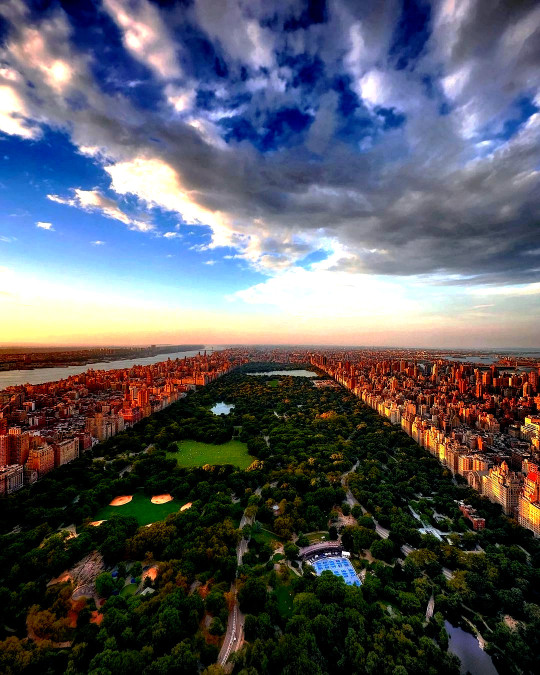
Central Park is a famous and iconic urban park located in the heart of Manhattan, New York City. It is one of the most visited and well-known parks in the world, covering an area of approximately 843 acres (341 hectares). Central Park offers a wide range of recreational, cultural, and natural attractions for both residents and visitors to enjoy.
Here are some key features and aspects of Central Park:
History: Central Park was designed by landscape architects Frederick Law Olmsted and Calvert Vaux and was officially opened in 1858. It was created to provide a green oasis in the midst of the rapidly growing and industrializing city, serving as a place for relaxation, recreation, and cultural enrichment.
Landscape and Design: The park's design incorporates a diverse array of landscapes, including open meadows, woodlands, ponds, lakes, and formal gardens. It features winding pathways, picturesque bridges, and scenic vistas. The design was influenced by the "romantic" or naturalistic style, with the intention of creating a harmonious environment where visitors could escape the hustle and bustle of the city.
Attractions: Central Park boasts numerous attractions, including:
The Central Park Zoo: A small but popular zoo within the park.
The Central Park Conservatory Garden: A beautifully landscaped formal garden.
The Great Lawn: A vast open space often used for concerts and events.
The Jacqueline Kennedy Onassis Reservoir: A scenic jogging and walking track around a large reservoir.
Bethesda Terrace and Fountain: An iconic gathering spot with stunning architectural features.
Strawberry Fields: A tribute to John Lennon, featuring the "Imagine" mosaic.
The Loeb Boathouse: Offering boat rentals and dining with a view of the Central Park Lake.
The Metropolitan Museum of Art: While not technically part of the park, it is located along its eastern edge, often referred to as the "Museum Mile."
Activities: Visitors can engage in a wide range of activities within Central Park, such as jogging, picnicking, biking, bird-watching, horseback riding, and ice skating in the winter. The park also hosts various events, including concerts, theater performances, and outdoor movies during the summer months.
Conservancy: The Central Park Conservancy is a private, nonprofit organization that plays a significant role in maintaining and preserving the park. It raises funds for park improvements, restoration projects, and ongoing maintenance efforts.
Filming Location: Central Park has been a popular location for movies and television shows over the years, making it instantly recognizable to audiences around the world.
Central Park's enduring popularity and iconic status make it a must-visit destination for anyone traveling to New York City. It provides a peaceful and natural escape in the midst of the urban jungle and serves as a testament to the value of green spaces in urban planning.
#Central Park#new york city#new york#manhattan#newyork#new-york#nyc#ny#urban#city#usa#United States#buildings#travel#journey#outdoors#street#architecture#visit-new-york.tumblr.com
173 notes
·
View notes
Text
Martha Wells is just such a master of this particular style of world building where she’s able to communicate *so* much through significant details and trusting her readers to pick up what that means for the deeper implications about her world.
The best example of this is probably in the first Murderbot novella, where Murderbot describes the scientists it’s guarding as coming from a “non-corporate political entity,” letting you know right away that, a) there are corporate political entities and b) Murderbot considers them the default with exceptions identified through contrast. Which tells you just *oceans* about the techno-futurist world this takes place in and Murderbot’s position in it in a single three word phrase.
I want to talk about all the cool world building detail in Witch King but at the same time I don’t because watching that world get revealed as you put together everything the key details tell you about how it works is such a great joy of reading it that I don’t want to take it from anyone.
There are at least four distinct systems of magic practiced by different cultures in this world and not only was I never confused despite not being given an expository essay on how any of them work or how they were different, but every detail about them was enrichment in the enclosure.
164 notes
·
View notes
Text
Commander Cody is actually something that can be so personal because he has so little screen time and (tragically) scant little in way of development (comparative to other main characters, like Rex or Fives for example) but everyone fell in love with him anyway, and started to fill in the gaps with stuff that makes the little that we still see mean a lot more? Does that make sense?
Like-- the myriad of interpretations fill in sooo many gaps of his character that not only enrich the narrative as a whole but everyone else's too! He's such a key player that we see so little of that whatever we see on him shapes the landscape of everything else.
Big Brother Cody being Marshall Commandder is like, what a position to be in! To care about so many brothers and be responsible for their lives and their deaths and to be up on that kind of pedestal, so accomplished in such a high position is so much pressure! It paints his character so great through TCW and even through TBB. Where'd he go! Where is he in rebels! It's all so interesting!
And one if the things that canon gives us over and over is that he WAS close with Obi-Wan which, romantically or platonically, makes their interactions little juicy morsels and filling on the gaps, how they came to care for eachother, how do they bond, how did their circumstances inform their relationship? There are so many great ways to take that...
"Commander Cody would x" or "Commander Cody would never x" no no Commander Cody *might* do those things! And how we take that shows the stories that we want told! But through all that-- almost always he reads as Cody... bugs bunny OUR Marshall Commander.
#mentally ill cody rant#commander cody#cc 2224#codywan#he is so special. to me. to us. he is barbie. he is everything.
222 notes
·
View notes
Text
Mobile phone screens from Resident Evil Village
One folder in the RE8 game files is mostly just images from smartphone screens. That includes a few you'll never actually see in the game ‒ like this one, which is pretty clearly a shot from the baby monitor we see Ethan activate after he puts Rose down to sleep.

Presumably, you were supposed to be able to view this image on his laptop or phone, but this feature never made it into the final game.
Other assets were technically used, but we never do get a good look at them. For example, remember when Ethan answers his phone in the flashback sequence while he's unconscious? We only see the phone screen display the words 'Calling', and then later, when he gets another call, 'Work'. But between the two, you can almost see a name pop up as he answers his phone.



Turns out it was Dr Castelli. Which (in a neat detail) does look to match the signature on Rose's medical report (you can find it in a drawer in Ethan's home, and I've already talked its significance to death), which plainly starts with a 'C'. Apparently the doctor's first name starts with a 'V'.

In even more random detail, remember when Ethan picks up and answers the broken cellphone after waking up by the overturned truck in the snow?

Turns out the number on it was 'HQ160805'!

I'm sure your lives are all very much enriched by knowing that.
Then there are the photos Chris shows off on his phone during the game ‒ like the four of Miranda at the ceremony site that he shows to Ethan.

But then we get to the other photos he flicks through later, and... look, seeing these out of context just makes them so much weirder.
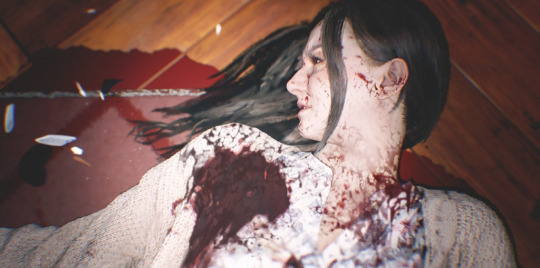
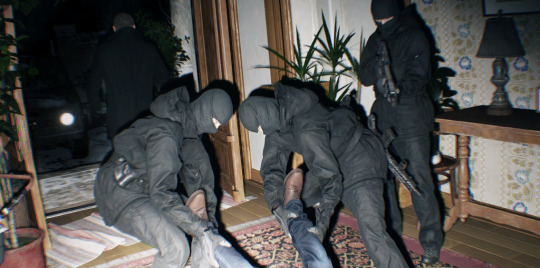
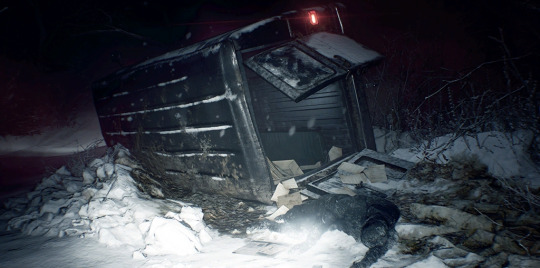
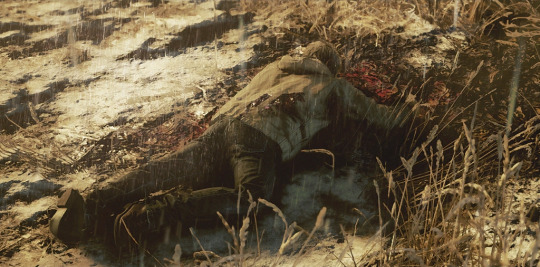
So, after shooting Mia/Miranda, someone on Chris' team stopped to snap a picture. While they were dragging Ethan's body out of the house by his feet, someone again took a photo, and made sure to send it to their boss.
It makes rather more sense to snap a photo of the scene at the overturned truck ‒ it's basically a crime scene, and for once, that's not even a body the team created themselves ‒ but we're starting to build a pattern here where snapping pics of every dead-or-unconscious body they come across is a key part of Dog-Dog-Squad protocol. Does Chris not believe people are properly incapacitated until he's seen photographic evidence? Or is this just a personal collection? Like, "Bad news, boss, Ethan's dead! Good news, I got you this great photo!"
Fuck, but they must've been busy when they got to the village ‒ there were bodies everywhere down there. I mean, is that why they got so little done? They were all too busy running around and engaging Photo Mode on every body they found?

Careful, team, some of those bodies are known to get back up again!
Oh who am I kidding, they've been working with Chris for years, they totally know that already.
126 notes
·
View notes
Text
HUMAN // THEORIES
Humans, or modern humans (Homo sapiens or H. sapiens), are the most common and widespread species of primate, and the only surviving species of the genus Homo. A great ape characterized by their hairlessness, bipedalism, and high intelligence, humans have large brains, enabling more advanced cognitive skills that enable them to thrive and adapt in varied environments, develop highly complex tools, and form complex social structures and civilizations.
I. SPECIES OF PRIMATE – in terms of biology, we fall under the classification of animals. we share more similarities with fellow species under this classification opposed to less similarities. study the behavior of fellow animals, limitlessly, and focus your attention on that of their primitive states-of-being. apply these tactics to our advanced state of multi-faceted intellect, and learn from them.
II. HIGH INTELLIGENCE – a privilege amongst humankind that, to an exponential degree, fails to be utilized by the masses. success in relation to survival is largely attributed to this level of intelligence on a day-to-day basis. with the exception of cases linear with cognitive neurodiversity—excuses against the enrichment and manifestation of this attribute remain impotent. failure to both utilize and acknowledge this predisposition will only lead to mortal sterility.
Humans are highly social, with individual humans tending to belong to a multi-layered network of cooperating, distinct, or even competing social groups—from families and peer groups to corporations and political states. As such, social interactions between humans have established a wide variety of values, social norms, languages, and traditions (collectively termed institutions), each of which bolsters human society.
III. HIGHLY SOCIAL – as if an art form opposed to a science, one must not only enforce to find a comfortable balance regarding this subject, but also attune themselves into the identification of natural compatibility, emotional maturity, and self-interest of individuals they encounter. if one chooses to form a social attachment with a subject who’s imbalanced in any aforementioned concepts, a state of emotional/energetic hemorrhage may occur. ideally, one must invest the majority of their energy into those in which form a unified duality of mutual restoration with oneself; opposed to the inclination of self-sacrifice, fueled by a multitude of various factors. one must vigilantly prioritize themselves as to not grow tarnished in an act of preservation for not only themselves—but for the consistent nourishment of their otherwise deep-rooted connections in which an active catalyst has been established. avoid social martyrdom.
Humans are also highly curious: the desire to understand and influence phenomena has motivated humanity's development of science, technology, philosophy, mythology, religion, and other frameworks of knowledge; humans also study themselves through such domains as anthropology, social science, history, psychology, and medicine.
IV. HIGHLY CURIOUS – passions, as sacred as they can be bewildering, [sub]consciously occupy the largest percentage of our time. to be mystified by that of which is misunderstood may be one of life’s most-precious offerings. our pursuits in creativity reward us with a key which unlocks subliminal facets within our psyche, only to be comprehended at a later point in time. these lay the foundations at our primal core, and, as a divine mission which one chooses to either ignore or commence upon, choosing the latter inevitably trails the path toward self-actualization. a probable reason why we exist—without the ability to reference some comprehensive manual—is to polarize us toward what we will produce as an earth-bound monolith to perpetually inspire future generations of those impassioned by the very same mystical essence that once lay dormant within ourselves.
As of January 2024, there are more than 8 billion humans alive.
you uniquely represent 1 amongst eight billion.
radiate your inner light for those blind to the dark.
43 notes
·
View notes
Note
Hey Avery, I love this blog and the binary-breakers blog. They’ve both been a great help to me as I reconstruct my faith. But I’m struggling with something: my fiancé and I are scheduled to light an advent candle during the Sunday morning service at his church. Initially I was really looking forward to it, but by chance I was curious about how old Mary was when she bore Jesus, and when I looked it up I learned she could have been anywhere from 13-16. Moreover, some traditions put Joseph as being much, much older. It’s just hard not to think in a very . . . sinister direction when considering that context, especially as far as God’s role in this is concerned. What did you learn about this topic in seminary, if anything? Is there any hope that my “problematic” interpretation is unnecessary/invalid?
Hi there! I think it's lovely y'all are going to light an advent candle tomorrow, and I hope it's a meaningful experience! I also totally get your dismay about Mary's age at Jesus's birth.
To start with the facts: yes, Mary was almost certainly a teenager when betrothed to Joseph. The Bible doesn't give any confirmation of her age, but in both ancient Jewish culture and Roman culture, girls were usually married off not too many years after they started menstruating.
When it comes to Joseph's age, I do have some slightly relieving news — he's unlikely to have been the old man he's often depicted as in medieval art. (I actually had a fascinating conversation on this topic with queer Catholic art historian Amy Neville on my podcast that you can read or listen to here!) He almost certainly would have been older than Mary, but it's uncertain how much older.
In ancient Jewish culture, the "ideal" marriage was actually one between a man and a woman who were both in their teens, with an expectation that a man marry by age 20. Being able to support a wife & kids was a key indicator of manhood, so men were expected to get married as young as they could. But in practice, it was more common for men to marry in their late 20s / by age 30, which does mean that their wives would often be a good ten or fifteen years younger than they were.
The Bible doesn't tell us what age Joseph was when he and Mary were betrothed, but it's unlikely he was older than 30, just as it's unlikely she was older than 18.
So maybe that's not quite as discomfiting as the image of a much older Joseph, but by our modern standards, it's still pedophilia. So what do we make of that? And what did God think of that??
__
I believe it is an act of faith to be troubled by elements of scripture that should be troubling, rather than shrugging them off as being "God's will" just because they're in the Bible. I highly recommend Rachel Held Evans' book Inspired on this topic, which has a whole chapter on grappling with difficult biblical texts (you can read a long passage from it here).
While exploring our emotions and giving them holy space, it is also important to accept that biblical cultures are two thousand or more years old — the ancient world had completely different understandings of morality from us. That doesn't mean we shrug off displays of sexism or xenophobia in scripture — bigotry is bigotry, whether an ancient iteration or what we have today — but learning about biblical cultures enriches our understanding of why certain things, like slavery or women having little say in whom they marry, are present in the Bible (and often completely taken for granted by its human authors). It can help us distinguish between what is truly God-ordained, versus what the humans writing down their experience of God presume is God-ordained.
I appreciate how womanist theologian Wil Gafney explores the complexity of appreciating the Bible as an ancient human text while looking for Divine truth "between the lines":
“There is liberation in the gospel even though it is sometimes obscured by the structures of power that benefit from holding people captive. There is also a story in and between the lines of and behind the text we hold so dear that points to a liberation that not even the authors and editors of scripture were able to see clearly or, see their way to record.
Jesus was a rabbi, he would have never wanted us to cling to the letters and syntax of these texts as though they were his very body and blood but rather, his spirit and the Spirit of God, blow through them, ruffling and disturbing them and permitting us to read new truths in and out of them and, not lose sight of the ancient stories that are also part of our shared heritage."
___
When it comes to Mary's young age when betrothed to Joseph and approached by Gabriel to request her "yes" to carrying God's child, your question of God's "role" in that is a vital one to ask.
In Mary's world, a woman without a kyrios, a man to be her protector, was in a very precarious position. Mary has to be betrothed to someone in her teens. We don't know whether God "approves" of this cultural practice, but we can see how God works within this custom to ensure Mary's security throughout her life:
when Joseph plans to divorce her after she becomes pregnant with Jesus, God sends an angel to persuade him to stick by her;
when Jesus is dying on the cross, he ensures that his beloved will protect Mary after he's gone.
Throughout scripture, God largely seems to operate within a people's cultural expectations (with key exceptions, like how God insists Their people treat foreigners the same as members of the group, or when God warns against giving the people a king just because that's what all the other nations have). That's what I see here. Mary must have a husband to be secure in her culture, and I imagine God ensuring that that husband will be one who will treat her well.
__
Then there's the question of God espousing Mary — of the Holy Spirit "overshadowing" her so that she conceives Jesus. What exactly is this "overshadowing" act? Why is God getting a teen girl pregnant?
Again, Rev. Wil Gafney provides words that wrestle out the good news with this complexity. When reading Luke 1, she urges us to sit with our distress at the image of a powerful "male" figure (Gabriel) approaching a teen girl to tell her what's going to happen to her body:
"Sit with me in this moment, this uncomfortable moment, before rushing to find proof of her consent, or argue that contemporary notions of consent do not apply to ancient texts, or God knew she’d say yes so it was prophetic, or contend that (human) gender does not apply to divine beings, Gabriel or God, and the Holy Spirit is feminine anyway. Hold those thoughts and just sit in the moment with this young woman."
Our distress is holy; it shows our connection to a fellow human being, our thirst for justice. Honor what you feel, don't discard your emotions, even while you join them to sociohistorical understanding.
I highly recommend you read Gafney's whole article, but here's a little more from it that balances ancient culture with modern ethics:
"Yet in a world which did not necessarily recognize her sole ownership of her body and did not understand our notions of consent and rape, this very young woman had the dignity, courage, and temerity to question a messenger of the Living God about what would happen to her body before giving her consent. That is important. That gets lost when we rush to her capitulation. Before Mary said, “yes,” she said, “wait a minute, explain this to me.”
...
Did the Ever-Blessed Virgin Mary say, “me too?” Perhaps not. A close reading shows her presumably powerless in every way but sufficiently empowered to talk back to the emissary of God, determine for herself, and grant what consent she could no matter the power of the One asking. And yet in that moment after being told by someone else what would happen to her body, she became not just the Mother of God, but the holy sister to those of us who do say, “Me too.” "
Because Mary was a teen girl, an impoverished Palestinian Jew living under empire, she can extend solidarity to people across all time who experience similar oppression, whose bodily autonomy is equally precarious. Just as her son, God in human flesh, extends solidarity to all who have ever been arrested or executed under an unjust state through his crucifixion. Divine power is expressed in and through those whom the world denigrates and discards — that's why God chose Mary, and why Mary in turn chose God.
Sorry this got so long and has a lot of complex stuff to wrestle with. I honor your courage to ask the hard questions, and I hope you are able to take time throughout Advent to keep pondering! There are no easy answers, but wrestling can yield a blessing.
29 notes
·
View notes
Text
Nodes notes 🧭📚✨ pt 1
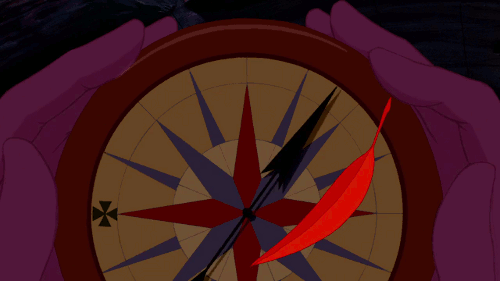
South/North Node notes
South Node in Capricorn or South Node in the 10th house represents an exacerbated focus on developing your own career, your life path, without connecting to the inner aspects of yourself and others around you. the way of looking at life becomes excessively traditional, linked to the steps that a person needs to develop and that society dictates: studying, going to college, getting married, having children, a car, having grandchildren, going to church, dying. doing everything "right".
this is complicated, because the person can also be distant from his/her own internal development. in addition to disconnecting from the ups and downs that life will bring, and which are fundamental for a deeper and unique development. see: when we move away from the ups and downs that life brings to us, we move away from our own development, since it is IMPOSSIBLE to follow a single path. however, Capricorn has an extreme difficulty with following different paths from what society says.
and that is the lesson of this placement: finding balance between inner and outer life. learn to develop your inner side, your emotions. remembering that, for better or worse, much of what we lack in ourselves will reflect on others around us. when I don't have empathy and openness with my emotions, I'll lack with the other in the same points. especially when we are faced with positions that tend to mean little awareness of oneself and the more abstract and emotional side of life. so, through the North Node in Cancer or the North Node in the 4th house, you must learn to develop empathy and your emotional side, your inner life. enrich yourself with emotional experiences!!! don't run away from them. what are you afraid of?
South Node in Virgo or South Node in the 6th house has the need to experience things only in a practical, rational, methodical way. it is necessary for you to know that the world is not made only of the tangible, of what is explained in the sense of concrete ideas. work your sensitive, spiritual and abstract side, through the arts, creativity, and maybe even understand that there are energies that affect us all the time, that affect you, but that you haven't even realized yet because you have a mental closure to that. North Node in Pisces / 12th house can help you with this. delve into this position. the key is within all of us - or outside too, in parts.
South Node in Leo or South Node in 5th house believes that the decisions he makes without consulting others are the best, he also tends to see only his personal lens, which takes little account of others. in addition, there is a tendency not to know how to share your resources with the social, there is a limit in the vision of what you can do for others. it is important to understand your social role in society as well, which the North Node in Aquarius or North Node in 11th house brings as a lesson.
South Node in Aries or South Node in 1st house has a profound difficulty in seeing the different facets of the human personality, in addition to not being able to understand different parts of the same subject, possibilities of conversations. people with this placement have had a past life full of individualism, have left people aside in their other experience, and have in the North Node in Libra / North Node in 7th house the lesson of improving their view of others, of the existence of people around them it is necessary to learn to see people, their needs, and stop living only on their own needs. there can also be a great difficulty in understanding what a love relationship is in its depth: the deepest exchanges, the Libra/Venusian way of relating. this placement may have a certain aversion to experiences/people with normal and natural exchanges in relationships, with understanding, with harmony. these people may seek a relationship in which they dominate, having misunderstanding with those who do differently. as unfortunately there is a tendency to be very imposing and intolerant, this placement can mean a judgment of others who deviate from their standard of living. that is: people who, for example, have very Libran/Venusian relationships or experiences, with healthy exchanges, harmony, search for balance, knowing how to give, and not just wanting to receive, can be seen as "fool" by those who have this position. it's a big possibility.
South Node in Gemini or South Node in 3rd house needs to understand the need to know things more deeply. try to have deeper interests, not just the basics. knowing things in a deeper way can help you in your knowledge of yourself and the world around you. beware of wasting energy on superficial things. watch out for quick judgments of what you know little about.
South Node in Aries or South Node in 1st house has difficulty accepting help, difficulty letting go of the image of independence, image of a person who doesn't need anyone. another problem of South Node in Aries or South Node in 1st house is an aversion to what is different, believing that they don't need anything else, because they are enough on their own. be careful, with that attitude you can be forever stuck in the 1st house, lol. without leaving there, without knowing other houses. focused only on yourself, just listening to yourself, literally living in a bubble.
South Node in Taurus or South Node in the 2nd house can tend towards an exaggerated comfort zone, which can lead to a certain stagnation in life. including material stagnation. while Taurus thinks it's okay to live in material sameness, with the same house, the same things, with the same pattern for so long, this can mean stagnation and impediment for new material resources or material experiences to emerge. seek experiences beyond the material level. don't be afraid to get lost in life (North Node in Scorpio or North Node in 8th house). why are you afraid of losing material control?
South Node in Capricorn or South Node in the 10th house needs to understand that society is on the move, and that old patterns of thinking no longer make sense. QUESTION social institutions: family, politics, religion. understand that to live attached to the past is to be inclined to repeat it, without learning from it. learning from the past is doing different. understand that only the old, the same thing as always, occupies a certain space. and this space being eternally occupied by the past and the traditional will never make room for the new, if you don't understand that. so, make room for the old and the "comfortable" to be replaced by the new and something that challenges you - even emotionally! beware of a tendency to think you know exactly what others need. not. we are different and we need different perspectives for the same situation. don't impose your 'standards of functioning' on others. this can drive people away.
South Node in Capricorn or South Node in the 10th house can represent a certain material selfishness, inability to share your resources with others. focusing excessively on your career and reputation development can put your relationships aside (North Node in Cancer/4th house) balances the need to develop your relationships and your career.
bonus
the negative face of Saturn, and which is often present in its natives (Capricorns or people with strong Saturn in the chart) is the idea that they know what is best for others, more than people themselves. this can become irritating, as they will often err in their readings of reality, as they tend to see it from a traditional, closed point of view, without understanding the various facets of who we are.
Aries is a sign that really needs to learn to vibrate in a less individualized energy. pay attention to your need to impose your wills on others.
#aries#saturn#north node#south node#south node in capricorn#south node in 10th house#north node in cancer#north node in libra#north node in 7th house#north node in pisces#north node in 12th house#south node in virgo#south node in taurus#south node in 2nd house#south node in 6th house#south node in aries#south node in 1st house#south node in gemini#south node in 3rd house#north node in scorpio#north node in 8th house#astrology#astrology notes#astrology observations#astro notes#Nodes notes#south node in leo#south node in 5th house#north node in aquarius#north node in 11th house
319 notes
·
View notes
Text
في الحياة، نحن كأزهار لا نزهر بالمجان. نمر بالكثير من التحديات والصعوبات قبل أن نتمكن من الظهور بكامل جمالنا وروعتنا. قد نبتسم في نهاية المتاهات، ولكنها تظل تجارب صعبة علينا. ننتصر على الأحزان لكن بعد أن نكون قد تألمنا وتألمت أرواحنا.
تلك التجارب والتجارب التي صقلت أرواحنا وشكلتنا كما نحن اليوم. نجتاز فصولاً في حياتنا تجعلنا نتذوق مرارة المعاناة قبل أن نشهد ختامها بشكل مشرق ومبهج. نحن كفراشات تخرج من الشرنقة بعد أن تحملنا المرارة والصعوبات، ولكننا نظل فراشات زاهية الألوان تحمل القوة والجمال في آن معًا.
قد لا ندرك قيمة تلك التحديات والصعوبات ونحن نعيشها، ولكنها تشكلنا وتجعلنا أقوى وأكثر إثراءً. إنها تدريب مكثف لأرواحنا وعقولنا، وفي نهاية المطاف، تجعلنا نزهر بأجمل وأبهى صورة.
يجب أن نتذكر دائمًا أن كل ما نمر به ونتخطاه يُشكلنا ويُصقلنا. إنها أشبه بعملية نضوج الزهرة، حيث يتطلب الأمر وجود ماء وشمس وتربة خصبة لتستطيع الزهرة النمو والازدهار. وبالمثل، فإننا نحتاج إلى الصبر والقوة والإيمان لتجاوز التحديات والمصاعب التي نواجهها في حياتنا.
أن نكون متفائلين وصابرين يمكن أن يكون مفتاحًا هامًا في مواجهة الصعاب والتحديات. فالأمل والإيمان بأن هناك نهاية سعيدة لكل تحدي يمكن أن يمنحنا القوة للتغلب على الصعوبات والانتصار في النهاية.
ولكن علينا أيضًا أن نتذكر أن النضوج والازدهار يحتاجان إلى وقت وجهد. فالزهرة لا تزهر في ليلة وضحاها، بل تتطلب عناية وعمل مستمر وصبر لكي تتفتح بكامل جمالها. وبالمثل، فإننا يجب أن نكون صبورين ونعمل بجد لنحقق أهدافنا ونتحقق من الداخل والخارج.
من الصعب أن تنسى المصاعب التي تجاوزتها والألم الذي تحملته. ولكن من الأهمية بمكان أن نتذكر القوة التي كسبناها والحكمة التي اكتسبناها من تلك الصعوبات. إنها تجارب قاسية، ولكنها تعطينا الفرصة لتطوير أنفسنا وأن نكون أقوى وأكثر إحكامًا.
في النهاية، نحن كفراشات ننمو ونتغير ونتحول. نصبح أقوى وأجمل بفضل تلك الصعاب التي تجاوزناها. ومن خلال التحديات والصعوبات التي نواجهها، ننمو ونزدهر ونكون قادرين على الطيران بحرية وجمال. إنها رحلة صعبة، لكنها تجعلنا نكتشف عظمة قوتنا وترسيخ جمال أرواحنا.
In life, we are like flowers that do not bloom for free. We go through a lot of challenges and difficulties before we can show our full beauty and splendor. We may smile at the end of the mazes, but they remain tough experiences for us. We overcome sorrows, but only after we have suffered and our souls have been hurt.
Those experiences and trials have shaped our souls and formed us into who we are today. We go through chapters in our lives that make us taste the bitterness of suffering before we witness their conclusion in a bright and delightful way. We are like butterflies emerging from the chrysalis after bearing bitterness and difficulties, but we remain brightly colored butterflies carrying strength and beauty at the same time.
We may not realize the value of those challenges and difficulties as we live through them, but they shape us and make us stronger and more enriched. It's an intense training for our souls and minds, and ultimately, it makes us bloom in the most beautiful and splendid way.
We must always remember that everything we go through shapes and refines us. It's akin to the process of a flower maturing, where it requires water, sun, and fertile soil to be able to grow and flourish. Similarly, we need patience, strength, and faith to overcome the challenges and difficulties we face in our lives.
Being optimistic and patient can be a key factor in facing hardships and challenges. Hope and belief that there is a happy ending to every challenge can give us the strength to overcome difficulties and triumph in the end.
But we must also remember that maturity and flourishing take time and effort. A flower does not bloom overnight; it requires care, continuous work, and patience to fully unfold its beauty. Likewise, we must be patient and work diligently to achieve our goals and develop internally and externally.
It is hard to forget the difficulties we have overcome and the pain we have endured. But it is of great importance to remember the strength we have gained and the wisdom we have acquired from those hardships. They are harsh experiences, but they give us the opportunity to develop ourselves and become stronger and more resolute.
In the end, we are like butterflies - growing, changing, and transforming. We become stronger and more beautiful thanks to the difficulties we have overcome. Through the challenges and difficulties we face, we grow and flourish, and we are able to fly freely and beautifully. It's a tough journey, but it allows us to discover the greatness of our strength and to solidify the beauty of our souls.
Hayatta, biz çiçekler gibi bedelsiz açılmıyoruz. Tam güzelliğimizi ve ihtişamımızı gösterebilmeden önce birçok zorluk ve engel ile karşı karşıya kalıyoruz. Labirentlerin sonunda gülümseyebiliriz, ancak bunlar bizim için zorlu deneyimler olarak kalıyor. Acıları yeniyoruz, ancak bu acıları çektikten ve ruhlarımız zedelendikten sonra gerçekleşebiliyor.
Bu deneyimler ve sınavlar ruhlarımızı şekillendirdi ve bugün olduğumuz kişi haline getirdi. Hayatımızın bizi zorlukla buluşturan bölümlerinden geçerek acının tadını alıyoruz, ama onların parlak ve keyifli bir şekilde sonuçlandığına şahit olmadan önce. Zorlukları ve sıkıntıları çekmiş kelebekler gibi, acı ve zorluklarla dolu deneyimler sonucunda ortaya çıkmış olmamıza rağmen, biz yine de güçlü ve güzellik dolu kelebekleriz.
Bu zorlukların ve sıkıntıların, yaşadığımız sürece değerini anlamamız belki mümkün olmayabilir, ama bizi şekillendiriyor ve daha güçlü ve zengin bir hale getiriyor. Bu, ruhlarımız ve zihnimiz için yoğun bir eğitim ve sonunda en güzel ve ihtişamlı şekilde açmamızı sağlıyor.
Bu yaşadıklarımızın bizi şekillendirdiğini ve olgunlaştırdığını daima hatırlamalıyız. Bu, çiçeğin olgunlaşma sürecine benziyor; büyüyüp gelişebilmesi için su, güneş ve verimli bir toprağa ihtiyaç duyar. Benzer şekilde, hayatımızdaki zorlukları ve güçlükleri aşabilmek için sabır, güç ve inanca ihtiyacımız var.
Olumlu ve sabırlı olmak, zorluklarla başa çıkmak için önemli bir faktör olabilir. Her zorluğun mutlu bir sonu olduğuna inanmak, bize zorlukları aşma gücü verebilir.
Ancak olgunlaşma ve gelişme zaman ve çaba gerektirir. Bir çiçek bir gecede açmaz, tam güzelliğini ortaya çıkarabilmesi için bakım, sürekli çalışma ve sabır gerektirir. Benzer şekilde, hedeflerimize ulaşmak ve içsel ve dışsal olarak gelişmemiz için sabırlı olmalı ve özveride bulunmalıyız.
Aşmış olduğumuz zorlukları ve çektiğimiz acıları unutmak zor olabilir. Ancak bu zorluklardan elde ettiğimiz gücü ve kazandığımız bilgeliği hatırlamanın önemli olduğunu unutmamalıyız. Bunlar zor deneyimler olabilir, ancak bizi gelişmemiz ve daha güçlü ve kararlı olmamız için bir fırsat sunuyor.
Sonuç olarak, biz kelebekler gibi büyüyor, değişiyor ve dönüşüyoruz. Aşmış olduğumuz zorluklar sayesinde daha güçlü ve daha güzel hale geliyoruz. Karşılaştığımız zorluklar ve sıkıntılar sayesinde büyüyor ve gelişiyoruz ve özgürce ve güzelce uçabiliyoruz.
Bu zorlu bir yolculuk olabilir, ancak gücümüzün ve ruh güzelliğimizin büyüklüğünü keşfetmemizi sağlar.
Na vida, não florescemos de graça como as flores. Enfrentamos muitos desafios e obstáculos antes de podermos mostrar toda a nossa beleza e magnificência. Podemos sorrir no final dos labirintos, mas eles continuam a ser experiências desafiadoras para nós. Superamos a dor, mas isso só pode acontecer depois de termos sofrido e de nossas almas terem sido danificadas.
Essas experiências e provações moldaram nossas almas e nos tornaram quem somos hoje. Saboreamos a dor passando pelas partes de nossas vidas que nos apresentam dificuldades, mas não antes de testemunhar sua conclusão brilhante e alegre. Embora tenhamos saído de experiências cheias de dor e dificuldades, como borboletas que suportaram dificuldades e tribulações, ainda somos borboletas fortes e cheias de beleza.
Podemos não ser capazes de compreender o valor destas dificuldades e problemas enquanto vivermos, mas eles moldam-nos e tornam-nos mais fortes e mais ricos. Este é um treinamento intenso para nossas almas e mentes, permitindo-nos finalmente nos abrir da maneira mais bela e gloriosa.
Devemos sempre lembrar que essas experiências nos moldam e amadurecem. Isto é semelhante ao processo de maturação de uma flor; Precisa de água, sol e solo fértil para crescer e se desenvolver. Da mesma forma, precisamos de paciência, força e fé para superar dificuldades e desafios em nossas vidas.
Ser positivo e paciente pode ser um fator importante para lidar com as dificuldades. Acreditar que todo desafio tem um final feliz pode nos dar forças para superar as dificuldades.
No entanto, a maturação e o desenvolvimento exigem tempo e esforço. Uma flor não desabrocha da noite para o dia, requer cuidado, trabalho constante e paciência para revelar toda a sua beleza. Da mesma forma, devemos ser pacientes e abnegados para atingir nossos objetivos e crescer interna e externamente.
Pode ser difícil esquecer as dificuldades que superamos e a dor que suportamos. Mas devemos lembrar que é importante lembrar a força e a sabedoria que adquirimos com estes desafios. Estas podem ser experiências difíceis, mas apresentam-nos uma oportunidade de crescer e de nos tornarmos mais fortes e determinados.
Como resultado, crescemos, mudamos e nos transformamos como borboletas. Ficamos mais fortes e mais bonitos graças às dificuldades que superamos. Graças às dificuldades e problemas que enfrentamos, crescemos e nos desenvolvemos e podemos voar livre e lindamente.
Esta pode ser uma jornada difícil, mas nos permite descobrir a grandeza da nossa força e beleza de alma.
20 notes
·
View notes
Note
https://www.tumblr.com/eisforeidolon/751943165375856640/do-you-consider-dean-to-be-abusive-to-sam-i-read
You are totally entitled to your opinion, but this reply was a not so much, "no, I don’t think Dean was abusive" response. It was more a "look at all the times Sam is meaner and worse than Dean" response, which is what Sam fans get accused of doing in reverse. The thing is, Sam girls ARE overly defensive of Sam, but it is partially because the show narrative itself almost always sides with Dean, as in his choices end up being "right" even when they logically shouldn’t be. Or sam just has to "get over" things or he’s a "bitch, but Dean is allowed to be angry and hurt without the show shitting on him for it. Sam even gets blamed for things that he didn’t even do (this is by Castiel often, though. And he sucks, so … whatever). Sorry, but just some backstory on why Sam girls get sensitive.
I don’t actually think Dean is abusive. I think he’s damaged and dealing in the way he knows how. And, yeah, both brothers hurt each other a lot by lying, saying harsh things, etc. I actually think the times either have punched each other, the other hardly counts as anything serious. Nit the big fights, but the single- punches. I’m not saying they are right, but growing up fighting monsters, a punch is going to mean less to both of them than not trusting each other or things like that.
Also, in my opinion, I get people’s annoyance at the whole Sam trying to get Dean to talk about things on his time frame isn’t cool. But, it results in Dean knowing he can open up when HE is ready. He always ends up sharing with Sam in th end. But, as the show goes on, Dean shuts doesn’t Sam’s attempts to talk about how he feels. So he stops. Sam is a bit hypocritical in wanting Dean to talk when he wouldn’t, yes, but he’s also learned that after being shut down a few key times. In the late seasons, both are better at sharing with each other, so they get there in the end.
Sorry, if this comes off as combative, but I agree with your initial point that they have both hurt each other in many ways. I think whoever we identify with, we are always going to give more leeway though.
Can’t we all just agree to hate Castiel for blaming Sam for things he hadn’t done, betraying Dean, and generally sucking?
Honestly, I mostly avoid a lot of the brother vs. brother conversations just because it is so hard to address it in a way that will not be taken badly by one side or the other because there are so many biased, rancid takes floating around. People can get very entrenched and defensive, which is kind of a shame. Not just because that's not fun, but people being willing to give their faves more leeway? Can actually lead to all kinds of interesting speculation and meta about the characters' choices that I think often enriches the fandom.
The initial premise of the anon was regarding claims Dean is abusive by people taking Dean's worst behaviors regarding Sam in a vacuum. Since I don't agree Dean was uniquely terrible to Sam specifically because they've both got issues with control and yes, their lives are violent and they've both gotten physical with each other? I wasn't sure how else to address that without pointing out Sam's side of that equation existing. And I did want to use some specific examples to avoid having to come back later and add them in because 'Well, *I* don't remember Sam ever...'
I did see how that could come off as harping on Sam, but I didn't really see a way around it. I could have tried to reiterate more of Dean's various behavior which was not great - but given that was baked into the initial premise and punching people when you're angry is kind of ... obviously bad? If there was a more even-handed way to say what I meant, it was sadly beyond my abilities when composing the post. But my intention was very much just to point out that the context in which Dean's behavior occurs is a relationship that's kinda fucked up sometimes from both sides, not to imply Sam was worse or meaner to Dean than Dean was to Sam.
11 notes
·
View notes
Text

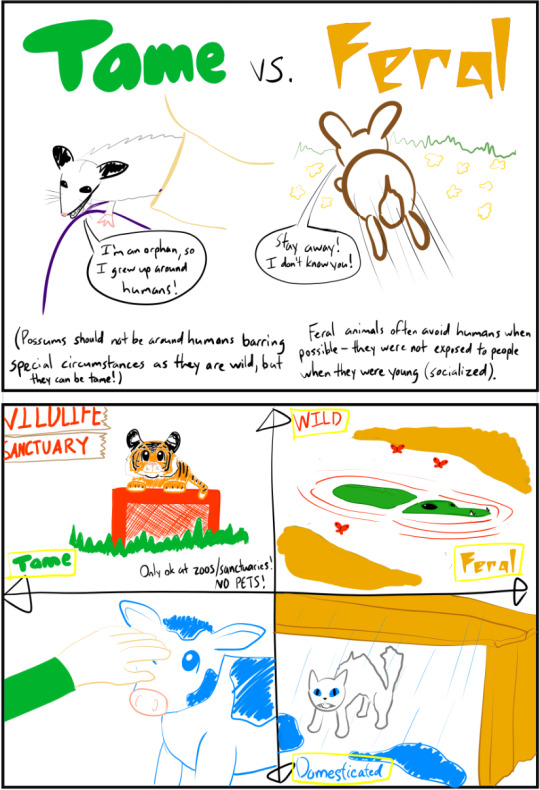

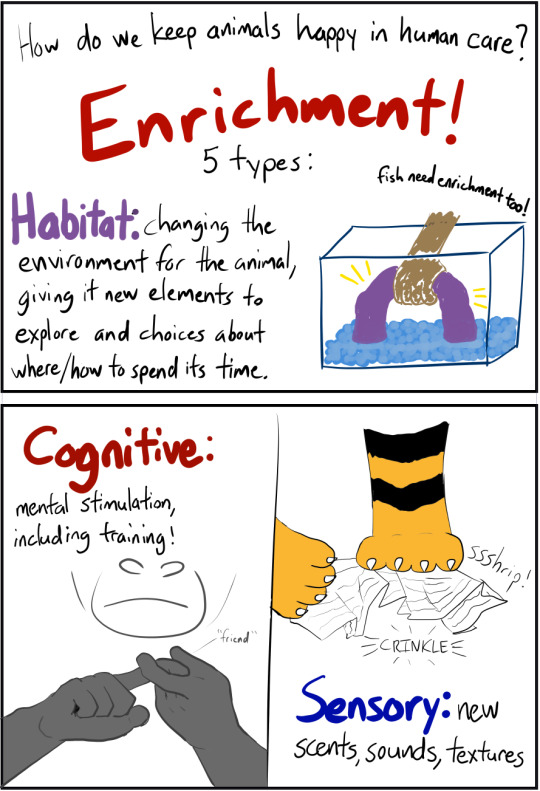

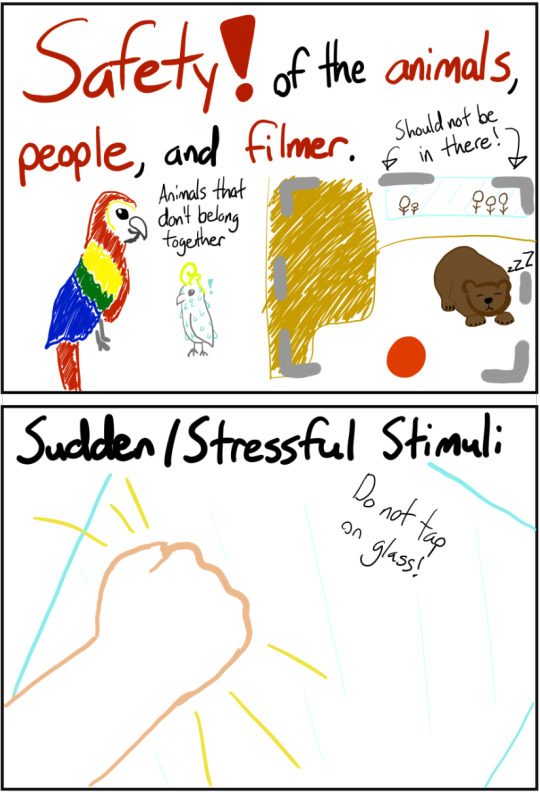
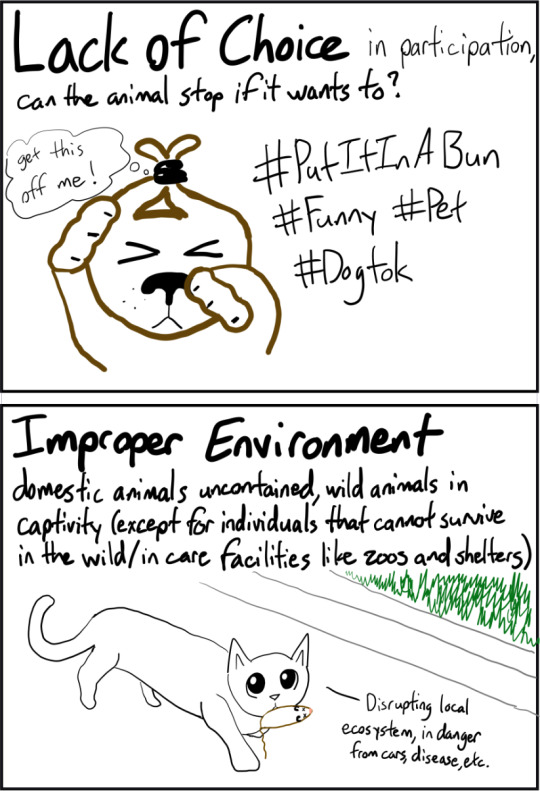
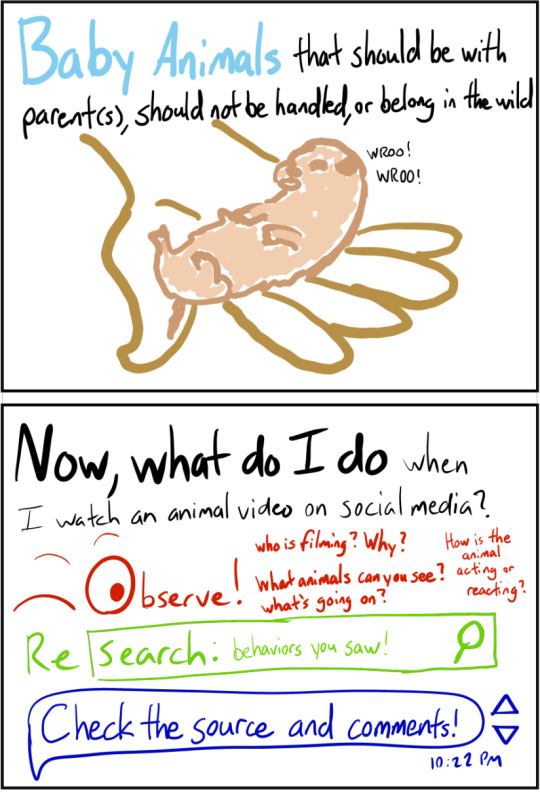


We have lots of wonderful accounts that do a great job of telling if the animal video is cute or not, but it's important for everyone to exercise critical thinking skills and learn how to analyze them too! Here's an infographic with some basics on animal science that can help you decide what to look for.
Key questions for analyzing videos:
Are all of the animals and people in the video (including the filmer) safe?
Is the animal choosing to participate?
What behavior or activity is being shown - is it a natural and positive behavior for the animal, is it enriching? Or may it be a negative behavior? You can search ‘animal’ ‘behavior’ online - like “gorilla picking itself” - for a quick check!
What’s the purpose of the video - is the situation created for the animal, or for viewers?
Is it sensible that the animal is there, doing what it is doing?
Overall - figure out what you can see, and what you need to find out/double check, and then search that! Add it all up and you should be able to draw your own conclusions too.
Please check out some of our other posts for examples on how to think through videos you may see!
Smithsonian’s National Zoo & Conservation Biology Institute. (2022, May 25). Animal Enrichment. Smithsonian's National Zoo. Retrieved March 28, 2023, from https://nationalzoo.si.edu/animals/animal-enrichment
Bielawski, J. (2017, January 5). Beware what you share! "Cute" videos are often cruel. Animal Help Now. Retrieved March 22, 2023, from https://ahnow.org/blog/2017/01/05/beware-what-you-share-cute-videos-are-often-cruel/
Goldstein, H. (2022, April 13). What to do when you see animal cruelty on Social Media. What to Do When You See Animal Cruelty on Social Media. Retrieved March 28, 2023, from https://www.worldanimalprotection.us/blogs/what-do-when-you-see-animal-cruelty-social-media
American Veterinary Medical Association. (n.d.). Animal welfare: What is it? Animal Health Welfare. Retrieved March 28, 2023, from https://www.avma.org/resources/animal-health-welfare/animal-welfare-what-it Colchester Zoo. (2022, February 11). Environmental enrichment. Colchester Zoo. Retrieved April 3, 2023, from https://www.colchester-zoo.com/about-us/environmental-enrichment/
124 notes
·
View notes
Note
How do I write a good monologue? Where a character has the upper hand over their rival, and they want them to KNOW IT
As a creative writer, mastering the art of writing a monologue can enrich your story and be a great tool for worldbuilding and revealing shocking truths. Characters may deliver monologues to express their inner thoughts, reveal their motivations, prove they have the upper hand, convey their emotions, or share their personal insights with the reader.
Understanding the reasons behind a character’s monologue can help you create one that is both compelling and resonant. Let’s explore the essential elements and techniques for how to write a monologue that truly connects with your audience.
Understand your character
Before writing a monologue, it’s essential to delve deep into the complexities of your character. Understand the motivations, fears, and desires that drive them both within the story, but also within the scene.
A well-crafted monologue should offer a window into the character’s inner world, revealing their personality and inner conflicts. By considering the character’s background, experiences, relationships, and the journey that led them to this point, you can discern how these elements have shaped their perspective and informed their voice. This depth of understanding ensures that the character’s monologue remains authentic, resonant, and true to their identity.
Establish theme and purpose
Every monologue should serve a purpose within your story. It’s crucial to know the thematic significance of the monologue and how it contributes to the overall narrative. Whether it serves as a moment of revelation, introspection, or a pivotal decision for the character, the monologue should align with the plot’s overarching themes.
A character’s emotional state when delivering their monologue is also a key element. Whether it’s passion, vulnerability, anger, or resilience, the language and tone should resonate with the character’s emotional journey, ensuring that it serves an integral part of their development and the story’s progression.
Craft compelling dialogue
When you write a monologue, pay close attention to the rhythm, pacing, and cadence of the dialogue. Consider the emotional state of the character delivering it, and let it influence the flow of their words.
Utilise vivid imagery, metaphor, and sensory details to create a striking and evocative monologue that engages your reader’s imagination. Experiment with the structure and length of the, allowing it to mirror the character’s state of mind. By carefully considering these elements, you can create dialogue that truly captivates and resonates.
Don’t infodump
Monologues can serve an important purpose in any story, and while a certain level of information reveal is necessary, it’s also important not to go overboard into infodump territory.
When you write a monologue, it’s essential to avoid excessive exposition of backstory or revealing plot details in a way that feels forced or unnatural. What this does is overwhelm your audience with large chunks of information, breaking the pacing and flow. Instead, try to integrate relevant details seamlessly into your character’s dialogue. Allow the information to unfold naturally, and make sure that you also reveal information at other key moments in the plot, rather than saving it all for a single monologue.
Embrace vulnerability and authenticity
A powerful monologue often stems from a place of vulnerability. Allowing your character to express raw and genuine emotions, even if they are conflicted or imperfect, can deeply resonate with the audience.
Try to avoid clichés and generic expressions; instead, infuse the monologue with your character’s unique voice and perspective. Authenticity and vulnerability not only add depth to the character’s words but also create a genuine connection with the reader, inviting them into the character’s inner world.
#writing tips#writing asks#writeblr#writing community#writers#creative writing#writing#writers of tumblr#writing inspiration#creative writers#writerblr#writing advice#writblr#novel writing#writing a monologue#writing dialogue#writers corner#let's write#writing resources#writers on tumblr#writers and poets#writer#writing quick tips#quick writing tips#tips for writers#advice for authors#helping writers#writing help#help for writers#writing tips and tricks
119 notes
·
View notes
Note
More weird things about the Lover mv your post made me notice! The pink bedroom has curtains behind the bed. Like stage curtains, floor to ceiling, and they're closed. And they're not for the window, because we can see the window. Also, you can see the reflection of the closed door in the mirror, but you shouldn't be able to, from the angle it's at. That door should not reflect in that mirror!
The Lover house is like a carnival funhouse. Everything slightly off-key, crazy and wrong. If you don't believe in the stunts, nothing about this mv makes sense. Why are these themes there? Why does this imagery keep recurring in her work? Taylor's work is enriched so much when you can pick up what she's putting down. I feel sad for people who miss it
Oo Anon thank you for popping in and referring back to this old post with some fun additions. Your thoughts on the curtain behind the bed are great. I can see it being a stage. And I never noticed the door in the reflection of the mirror! Great eye! I wonder if it has any connection to her tour visuals where she climbs through the mirror in the lover room and is then is next seen sitting in the upside down world version of that house in front of the vanity before she burns the house down.
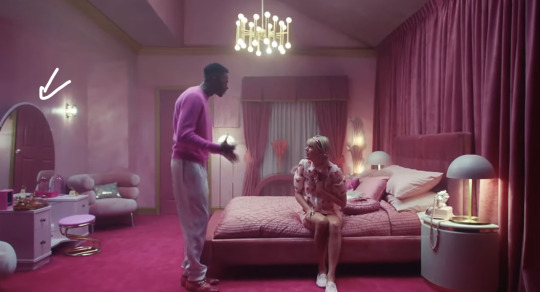
46 notes
·
View notes
Note
If I got the keys to a mech I'd never fucking go to work a day in my life again. I'll take my fucking giant robot to the drive thru and say "One double cheeseburger, please" and they'll say "here you go, on the house for our favorite Char clone" and you can ignore that last part. I won't even pay rent, I'll live in my mech and it'll be way cooler than living in my car because my robot can kick ass and I can't fuck my car
this ask is great and I totally agree but when I fucking opened it to respond it has collapsed all your text vertically as if it was a poem?? anyways yeah I'd also get burger and fuck my mech too but also have you considered letting your mech fuck your car for like enrichment
#fucking baffled why did tumblr do this??#also yeah so valid for mech fucking tbh mechs are hot#idk what a char clone is i assume its something for Real Mech Heads alas i am just a poser#i like evangelion because im sad and gay and i watched like half a gundam series#anyways thanks you for the ask anon sorry this happened to it but its so funny#asks#anon
24 notes
·
View notes
Text
Deadline Detroit | Slavery is Detroit's big, bad secret. Why don't we know anything about it?

Metro Detroiters love to celebrate their local history, especially when it involves the noble, magnificent and world-class chapters of the past: The auto industry. Motown Records. The Underground Railroad. Diego Rivera. Coney Islands.
On the other hand, local history has its crazy uncles. Those are chapters that might be fascinating and important, but they are hidden in the back room and rarely talked about. Henry Ford’s anti-Semitism, taking land from the Indians, the Free Press’ 19th Century racism and the auto companies’ early abuse of workers come to mind.
Then there is the granddaddy of all forgotten local history. The subject no one talks about, virtually ever. The most neglected topic of all.
youtube
Slavery.
Slavery in Detroit has remained an enormous secret. It is an essential chapter in Detroit’s 311-year story, but it has been pushed back into archives and covered up by decades of neglect and denial. Few people, even well-informed college graduates, know that slavery played a key role in the growth of Detroit, and wealthy Detroiters owned slaves for the first 120 years of the city's existence.
When metro Detroiters talk about slavery, they talk about black men and women picking cotton in Georgia and Mississippi because that is what students in southeastern Michigan learn in school.
Yet slavery is very much homegrown. What has been called the “national sin” is also Detroit’s sin. It is the origin of our racial crisis, our peculiar institution, our “necessary evil.” Slavery belongs to Detroit just like slavery belongs to Charleston, Monticello and New Orleans.
Many roads, schools and communities across southeast Michigan carry the names of old, prominent families that owned slaves: Macomb, Campau; Beaubien; McDougall; Abbott; Brush; Cass; Hamtramck; Gouin; Meldrum; Dequindre; Beaufait; Groesbeck; Livernois and Rivard, among many others.
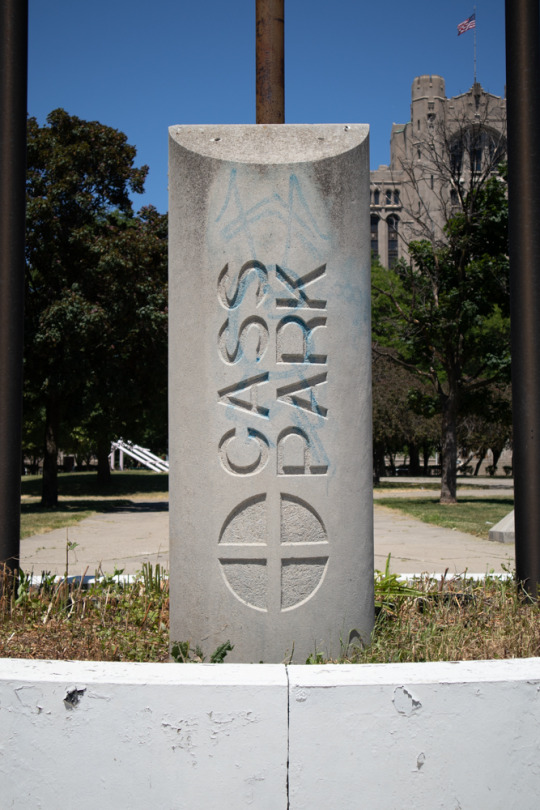
Detroit’s first mayor, John R. Williams, the namesake of two streets in Detroit – John R and Williams – owned slaves. The Catholic Church in Detroit was heavily involved in slavery – priests owned slaves and baptized them, and at least one slave worked on the construction of Ste. Anne’s Church around 1800. The men who funded the Free Press when it was founded in 1831 were ex-slave owners, and the paper supported slavery during the national debate before the Civil War.
The work of slaves helped build Detroit. And just like in the South, slavery in Detroit was reinforced by violence. Slaves worked without any pay for their entire lives, under threat of the lash and death.
Owners used their power over slaves to steal their labor and enrich themselves. Slaves arrived in Detroit stripped of their identity, culture, family and often their name. They were frequently maimed from torture.
Slaves died, often young, and were buried in graveyards that were soon forgotten, and then paved over by later generations of Detroiters, and their bones remain underfoot in America’s blackest big city, and their stories continue to be unknown in a region where race always has been a consuming issue.
Slavery was as much a part of early Detroit as the fur trade. Most residents who could afford slaves owned them during Detroit’s French, British and early American periods, from the city’s founding in 1701 to the second decade of the 19th Century. In 1750, for example, toward the end of the French regime, more than 25 percent of Detroit residents kept slaves.
“Not surprisingly, Detroit’s slaveholders came from the wealthiest segment of French society and produced a disproportionate amount of the village’s grain and livestock,” writes Brett Rushforth in “Bonds of Alliance,” a new book about slavery in Quebec and the Great lakes area in the 17th and 18th centuries.
Rushforth’s book touches upon the subject of slavery in Detroit, and in so doing he helps raise the veil on the city’s hidden history. Another academic, the University of Michigan’s Tiya Miles, has begun researching the subject, and earlier this year she told NPR’s Michel Martin that slavery “had a multilayered aspect in Detroit.”
There are almost no physical reminders of slavery left in Detroit. But one artifact that remains is a scarred and cracked account book that has yellowed and brittle pages. It sits in storage in the Burton Historical Collection at the Detroit Public Library. The book belonged to William Macomb, the richest person in Detroit when he died in 1796.
Macomb owned Grosse Ile and Belle Isle and several houses and page after page of livestock, tools and furniture. Macomb also owned people. Listed prominently near the front of the book along with things like shovel tongs, saddle bags and goats, are the names of, or references to, 26 human beings: Scipio, Tom, Guy, Charlie… Only one, Jim Girty, had a family name. Together, the slaves’ total value was listed as 1,655 pounds in New York currency.

In his will, Macomb wrote: “I give and bequeath to my loving wife, Mrs. Sarah Macomb, for her own use, all my moveable estate wheresoever…my slaves, cattle, household furniture, books, plates, linen, carriages and my utensils of husbandry.”
I examined that book last week, with a librarian and photographer. It is stark. We acknowledged that it felt strange to look at a simple page with lovely penmanship that represents a national horror involving so much human suffering.
Detroit’s history of slavery is complicated by the fact that African Americans were not the only people held in captivity. Native Americans were also enslaved here, especially during the early decades of the 18th Century when the French ran Detroit.
Indian slavery pre-dated the arrival of Europeans, and it was a very different system than the form of black slavery that Europeans brought to North America. Indians did not consider slaves property, and in native culture slaves possessed symbolic value, and were used as gifts during trade and negotiations, and to take the place of dead warriors.
Eventually, though, Indian slavery mixed with European slavery and produced a hybrid form of bondage that played a major role in relations among Indians and Europeans in Detroit throughout the 18th Century.
Slavery was important, for example, in the interaction between men and women. Traders in Detroit’s early days used female Indian slaves as backcountry wives, both for companionship and as a way to ingratiate themselves with the women’s relatives, which enhanced the traders’ ability to do business with the Indians.
During the British era, one of Detroit’s most successful traders was John Askin, who had three children with an Ottawa woman named Monette, a slave he owned and later freed. Askin was known for his aggressive business tactics, including plying Indians with alcohol. His papers, also preserved at the Burton Collection, show he bought and sold several native and black slaves during his career.
“Rum and sex paved the way for Askin’s success,” wrote historian E.A.S. Demers.
“Sexual violence permeated the slave experience” in the Great Lakes, wrote Rushforth. Many women, he added, like Monette, eventually rose to social acceptance and freedom, but not before a “prolonged submission to what could be defined as serial rape.”
Whether male or female, life was harsh for slaves on the Detroit frontier. They generally slept on the kitchen floors of Detroiters’ homes, and the record is clear that owners did not hesitate to flog their human property when they believed discipline was called for.
Yet in slavery's scale, Detroit was not South Carolina. Detroit’s simple trading economy, small population and modest farms did not require large numbers of slaves, and slaves in Detroit generally lived in closer proximity to their owners than slaves in the south.
Slaves never exceeded 10 percent of the population in Detroit; in the south before the Civil War, slaves made up 33 percent of the population. In Detroit, Macomb was the biggest slave owner, with a couple of dozen slaves; in Virginia, Thomas Jefferson owned some 600 slaves in his lifetime. Jorge Castellanos, a former professor at Marygrove College, once wrote that Detroit was not a “slave society,” but a “society with slaves.”
Forgetting
Grosse Ile, once owned by William Macomb, is the largest island in the Detroit River. Residents have done a lot to keep alive the community’s long history. But no one knew anything about the Macomb family owning slaves until Joel Thurtell, a Detroit Free Press reporter, brought it to their attention while he was doing a story in 2007.
Denise de Beausset, who is Macomb’s great-great-great-great-great granddaughter, told Thurtell: “No, I wasn’t aware of them having slaves at all. That’s funny; you’d think there would have been talk about slaves running the farm. Nobody ever talks about it on our side. I wonder if it was out of embarrassment or it wasn’t politically correct. Nobody ever talked about slaves. I’ll be darned.”
I have two friends whose roots in Detroit go back to the French period of the early 1700s. When I told them their ancestors had owned slaves, they thought I was joking. One friend, who had researched her family’s history, was flabbergasted when I broke the news.
“NO WAY!” she said. “Wow! Nobody told me anything about that, but I guess they wouldn’t. I am just embarrassed. That’s interesting. Fascinating.”
They are hardly alone in their obliviousness. Students of local history could research Detroit’s past for years before they would stumble across evidence of slavery. Since the early 1970s, slavery in Detroit has been the subject of research by a small number of scholars, who wrote academic articles that were mostly read by other academics and advanced students.
One graduate student, Arthur Kooker, wrote his doctoral dissertation in 1941 at the University of Michigan on abolitionists in Michigan before the Civil War. In his preface, Kooker wrote about his surprise when he discovered slavery itself had existed in Michigan.
“As the work progressed one fact that seemed to require an exploration kept bobbing up,” he wrote. “Rooted deep in Michigan’s past was the very institution which had called the antislavery movement into being.”
Remembering
During the first years of the 21st Century, many Americans discovered the story of slavery in the United States, especially as it existed outside the south. Prodded by activists and historians, a number of institutions and individuals acknowledged their historic ties to slavery and other extreme racist behavior, and in many cases asked for forgiveness.

A partial list of those performing a self-examination, and often issuing an apology or moving for reconciliation, includes President Bill Clinton (on behalf of the United States); Brown University; Yale University; Harvard University; Wilmington, N.C.; New York City; Philadelphia, Miss.; Duluth, Minn.; Birmingham, Ala.; London, England.; various insurance companies; the Southern Baptist Convention; the U. S. Senate; the Hartford Courant, the Raleigh News and Observer; the Lexington, Kentucky, Herald-Leader; J.P. Morgan Chase and several other banks.
Ira Berlin, one of the nation’s foremost historians of slavery, wrote in 2006 that “slavery has a greater presence than at any time since the end of the Civil War.”
Slowly, the curtain has begun to rise across the country on slavery and other forms of historical racism. Most notably, the collective amnesia is disappearing that allowed the north to absolve itself of involvement in slavery while castigating the south. People are realizing that understanding slavery is central to understanding the origins of America itself.
Detroit’s selective memory, however, has remained intact. Almost nothing has been done to seek out the truth about the role of slavery in Detroit’s history. And that seems unfortunate in a region where the theoretical underpinning of slavery – racism – remains a paramount issue.
It’s not a happy story. It’s probably not a coincidence that we celebrate the uplifting saga of the Detroit and the Underground Railroad rather than the tremendously sad story of Detroit and human captivity. For a nation – and city -- built on the notion of freedom, to consider the idea that slavery was also a major part of the foundation is difficult and disillusioning.
But telling the truth about our history can be a start on telling the truth about today.
“Slavery is the ground zero of race relations,” Berlin has written. “There is a general, if inchoate, understanding that any attempt to address the question of race in the present must also address slavery in the past.”
► Related: Detroit Landmarks And Roadways, And The Slave Owners They Were Named For
#Detroit#michigan#Slavery is Detroit's big#bad secret. Why don't we know anything about it#slavery in Detroit#slavery in michigan#northwest ordinance 1812#michigan territories#Youtube
15 notes
·
View notes